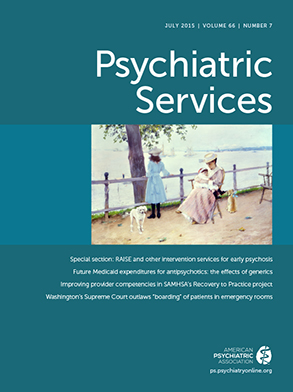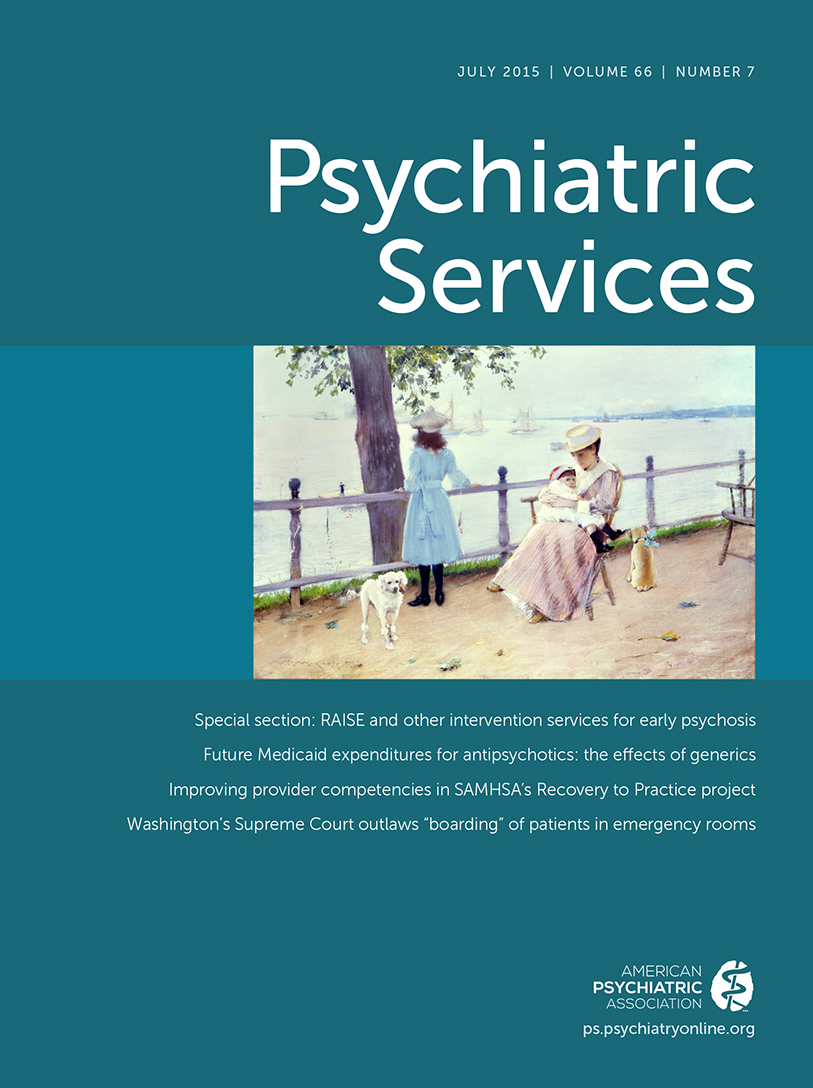The crisis intervention team (CIT) model is a police-based program, now in its 25th year, designed to improve law enforcement officers’ responses to individuals with mental illnesses or those in psychiatric crises (
1). CIT enhances collaboration between local law enforcement agencies, mental health services, and advocates; provides selected officers with 40 hours of specialized training (for example, verbal deescalation techniques); optimizes policies in both the public-safety sector (for example, pertaining to dispatch protocols) and mental health services (for example, ensuring officers’ continuous access to emergency receiving facilities); and builds a community of CIT-trained officers (for example, through annual conferences) (
2).
Methods
For the survey of police chiefs and sheriffs, data were collected with the REDCap electronic data capture system (
4). The study team partnered with the Georgia Sheriffs’ Association and Georgia Association of Chiefs of Police to e-mail a survey link (and a reminder one week later) to 159 Georgia sheriffs and 587 police chiefs. A total of 204 responses were received (27% response rate). Data from respondents were excluded if the survey was less than half completed or if the individual’s job title was not directly related to law enforcement, resulting in a final sample of 171. The survey included questions about respondents’ sociodemographic and agency characteristics. Those with a CIT program were queried about the nature of that program. Respondents whose agencies did not have a CIT program were asked about their intentions and barriers in regard to implementing CIT.
For the survey of CIT-trained and non–CIT-trained officers, the study team worked with the state CIT coordinator and five specific law enforcement agencies that had implemented CIT to e-mail a survey link to 3,439 officers and deputies, again using REDCap. A total of 378 responses were received (11% response rate). Exclusions were made as noted above, resulting in a final sample of 353. Like the survey of police chiefs and sheriffs, this survey included questions about respondents’ sociodemographic characteristics and perceptions.
The officers’ survey also included the five-item Andrews and Withey instrument to measure job satisfaction (
5). Past studies reported the instrument to be reliable and to have construct and criterion-related validity (
6). Cronbach’s alpha for internal consistency reliability was .78. Work burnout was measured with the ten-item Burnout Measure–Short Version (
7). This measure has been used in diverse professions—for example, with teachers (
8) and police officers (
9). Cronbach’s alpha was .89.
To concisely measure responses to a typical encounter scenario, officers were provided an eight-sentence vignette about a man named John with psychosis and agitation, analogous to the third scenario from a prior study (
10). At the end of the short vignette, John is 30 feet from the responding officer, holding a tennis ball–sized rock over his head and walking slowly toward the officer. Respondents were asked “On a scale of 0 to 10, how dangerous is John?” and “On a scale of 0 to 10, how unpredictable is John?” Other items pertained to how the respondent would resolve the situation.
Five variables pertaining to officers’ other training and work characteristics (for example, participating in police negotiator training, being a member of a SWAT team, and carrying an electronic control device) were included. In addition, as in prior studies (
10,
11), officers were asked about their exposure to mental health treatment (for example, “Have any of your family members ever received or are any currently receiving treatment for a mental health problem?”).
All study procedures were approved by the George Washington University Institutional Review Board, and all data were collected between July and September 2013. Because of the anonymous nature of the surveys, in lieu of signed informed consent, the introductory portion of the survey provided details of the study, and by proceeding to the survey, participants gave their consent for use of their data. Associations were tested with chi square tests and independent-samples t tests or Mann-Whitney U tests. Regression models were conducted to assess the independent effects of predictors on dependent variables while controlling for the effects of potential confounders. All tests were two-tailed, and the criterion for significance was p<.05.
Results
With regard to sociodemographic characteristics of police chiefs and sheriffs (N=171), most were male (N=156, 91%), non-Hispanic (N=168, 98%), and Caucasian (N=147, 86%). They had served in their current position for a mean±SD of about ten years (9.7±10.6 years). Their mean age was 51.5±9.2, and 28% (N=48) were U.S. military veterans. One-quarter (N=43, 25%) reported that their agency has a CIT program. Those with and without a CIT program did not differ on any sociodemographic variables. The mean number of uniformed patrol officers in the respondents’ agencies was 31.5±34.9. About half (N=92, 54%) reported that their jurisdiction has a drug court, although only 17% (N=29) reported having a mental health court. Among agencies with a CIT program, the mean total number of CIT classes ever held was 5.6±8.2, the mean number held per year was 1.2±1.3, and the mean number of CIT-trained officers was 33.0±50.0.
Among the 129 respondents reporting that their agency does not have a CIT program, 99 (77%) reported knowing what CIT is. When those 99 participants were asked, “Have you ever considered or thought about developing a CIT program?” 34% (N=34) responded, “No”; 55% (N=54) responded, “Yes, currently thinking about it”; 8% (N=8) responded, “Yes, currently planning one”; and 3% (N=3) responded, “Yes, currently developing one.” Among 95 responding to a question about barriers to developing a CIT program (options were not mutually exclusive), 57% (N=54) endorsed “We do not have enough officers,” 41% (N=39) endorsed “It is too expensive,” 38% (N=36) endorsed “Our officers cannot take that much time away from normal duty for the training,” 33% (N=31) endorsed “We do not have sufficient access to mental health services,” and 12% (N=11) endorsed “We do not have access to trainers.” No respondent endorsed “We do not need CIT.”
In the second survey of CIT-trained and non–CIT-trained officers (N=353), most were male (N=251, 71%), non-Hispanic (N=342, 97%), and Caucasian (N=258, 73%). The officers had served in their current position for 12.7±8.5 years. Their mean age was 41.5±10.0, and 35% (N=124) were U.S. military veterans. Because of the sampling approach, most participants were CIT-trained officers (N=273, 77%). The mean number of years since their CIT training was 3.9±2.8 years.
In terms of differences between officers with and without CIT training, those with training were less likely to be Hispanic, Caucasian, or a sheriff’s deputy and to work for a county (rather than a city); in addition, they were slightly older than officers without CIT training. CIT-trained officers were more likely to have had police negotiator training (21% [N=57] compared with 10% [N=8]; χ2=5.20, df=1, p=.023) and were more likely to carry an electronic control device (52% [N=142] compared with 26% [N=21]; χ2=16.29, df=1, p<.001), consistent with some law enforcement agencies’ procedures. CIT-trained officers were more likely to have family members who had received mental health treatment (47% [N=128] compared with 28% [N=22]; χ2=9.83, df=1, p=.002), to know someone within their circle of friends who had received treatment (51% [N=139] compared with 34% [N=27]; χ2=7.31, df=1, p=.007), and to have family or friends in the mental health field (40% [N=109] compared with 24% [N=19]; χ2=6.72, df=1, p=.010).
Non–CIT-trained officers reported on their familiarity with CIT. Among 80 non–CIT-trained officers, 88% (N=70) reported knowing what CIT is. Among 69 responding to the question “How much interaction have you had, on average, with CIT officers over the past year?” 29% (N=520) reported “no interaction with CIT officers,” 32% (N=522) reported “up to 4 hours per week,” 20% (N=514) reported “4–20 hours per week,” and 19% (N=513) reported “>20 hours per week.”
There were no significant differences between CIT and non–CIT-trained officers with respect to the six specific outcomes. To consider the effects of potential sociodemographic and background confounders, associations between the ten aforementioned factors that differed between officers with and without CIT training and the six outcomes of interest were examined. Four of the ten factors (job title, carrying an electronic control device, family history of mental health treatment, and history of mental health treatment of a friend) were associated with one or more of the six outcomes. Six models were therefore run that included the sociodemographic and background factors that differed by CIT status. In only one instance did a nonsignificant difference between CIT-trained officers and non–CIT-trained officers become significant. Specifically, when the analysis controlled for the fact that CIT-trained officers were more likely to carry an electronic control device, CIT-trained officers were less likely to report using force (defined as using pepper spray, physical engagement, or an electronic control device) in response to the vignette (for CIT training, odds ratio [OR]=.40, 95% confidence interval [CI]=.18–.92; for carrying an electronic control device, OR=2.58, CI=1.17–5.67).
Discussion
At least three key findings from these two relatively large surveys on CIT are noteworthy. First, police chiefs’ and sheriffs’ perceived barriers to implementing CIT included not having a large enough force, cost, difficulty with officers taking a week away from usual duty for the training, and insufficient access to mental health services. Addressing these barriers will be crucial to dissemination of CIT in diverse law enforcement agencies. Second, contrary to hypotheses, CIT-trained and non–CIT-trained officers did not differ in five of six areas examined (for example, job satisfaction and work burnout). Although at least one previous survey showed increased self-efficacy with CIT training (
12), and one might expect that increased self-efficacy would contribute to job satisfaction, additional research is needed to examine the assumption that CIT training improves job satisfaction. Third, when the analysis controlled for whether the officer carried an electronic control device (use of which was one of the response options in the scenario), CIT-trained officers were less likely than non–CIT-trained officers to use force in response to a scenario involving a man with agitated psychosis. This finding is aligned with results from a prior vignette-based survey (
10) but inconsistent with findings from a large sample of actual encounters that did not reveal differences in level of force (
13).
Several limitations should be noted. First, although surveys were sent to a large sample of police chiefs and sheriffs and a large sample of officers, and a sophisticated survey system was used, response rates were less than ideal. Second, because officers were drawn from a variety of law enforcement agencies, data were to some extent nested, which could not be accounted for statistically because data were not gathered on an officer’s specific agency to ensure anonymity and optimize the response rate. Potential department-specific and organizational factors, including those that might be pertinent to job satisfaction and burnout, could not be analyzed. Similarly, variation in CIT training, implementation of other elements of the CIT model, ongoing operations (for example, volume of CIT calls, percentage of CIT-trained officers in each department, and size of the department), and extent and nature of exposure to CIT officers could not be examined. Third, as is true of all survey-based data, responses to queries about behavioral decisions linked to a written vignette represent proxies for actual behavior; data on actual behavior are much harder to gather from a data collection perspective. Fourth, as is often the case, there was no means of examining the extent to which findings were influenced by selection bias (that is, which individuals who received the survey opted to complete it) and response bias (for example, social desirability effects). It is possible that officers experiencing less job satisfaction or greater burnout were less likely to participate. Fifth, given the observational nature of the study, there is no way to know whether any observed differences were due to CIT training or to characteristics that might draw some officers into CIT training.

